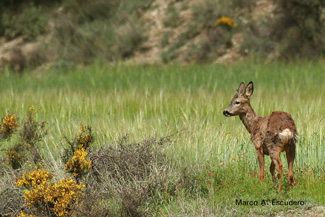Roe deer and toxoplasmosis in Spain

This work analyzes almost 300 roe deer from different regions in Spain, in order to get information about risk factors on the host-parasite relationship by T. gondii (responsible of toxoplasmosis). The study concludes that environmental factors are important, and indicates high exposure to T. gondii in Spanish roe deer.
In Spain, roe deer is an important game animal and its population is increasing. In the present study we determined seroprevalence of T. gondii infection in roe deer from Spain and provided epidemiological information on risk factors including effect of sex, age, geographic origin and climate (rainfall) on the host parasite relationship.
Sera from 278 roe deer sera from eight areas in mainland Spain were assayed for antibodies to T. gondii by modified agglutination test (MAT). Titers of 1:25 or higher were found in 109 (39.2%) of 278 deer. No significant differences in antibody prevalence were found between sex or age categories. In contrast, significant differences in seroprevalence between locations were evident.
Roe deer from the Northern coastal habitats (high humidity and roe deer density) had the highest prevalence, compared with low prevalence in Central Spain (arid areas and low roe deer density) (Kruskal-Wallis test, 7 d.f., Chi2=33.0, P<0.001). There was a significant correlation between mean local antibody prevalence and mean annual rainfall (rs= 0.85, n=8, P<0.01).
Our results indicated that environmental factors are important in the probability of T. gondii infection in roe deer in Spain. Humidity and moderate temperatures may favour oocyst survival and sporulation in the environment, facilitating parasite spread and maintenance. In addition, density populations of roe deer from the Atlantic regions are higher than those from dry Mediterranean habitats, and density is a well-known risk factor for many diseases including T. gondii infection.
Another possibility for the observed results could be due to man-related factors such as presence of domestic cats and human population dispersion, which can also affect the epidemiology of T. gondii. In summary, the present report indicates a widespread and high exposure to T. gondii in Spanish roe deer.
These findings have environmental and/or public health implications because venison can be an important meat source of T. gondii infections for humans and feral cats if meat is not adequately cooked.
(b)Departament de Sanitat i Anatomia Animals, Universitat Autònoma de Barcelona, 08193 Bellaterra, Barcelona.
(c)SEDIFAS, Veterinary School, University of Zaragoza, Zaragoza.
(d)Animal Parasitic Diseases Laboratory, Animal and Natural Resources Institute, Agricultural Research Service, United States Department of Agriculture, Beltsville, MD 20705, Estats Units.
(e)Servei d'Ecopatologia de Fauna Salvatge (SEFaS). Departament de Medicina i Cirurgia Animal. Universitat Autònoma de Barcelona, 08193 Bellaterra, Barcelona.
(f)Centre de Recerca en Sanitat Animal (CReSA), UAB-IRTA, Campus de la Universitat Autònoma de Barcelona, 08193 Bellaterra, Barcelona.
References
"Prevalence of antibodies against Toxoplasma gondii in roe deer from Spain". Gamarra, J. A.; Cabezon, O.; Pabon, M.; Arnal, M. C.; Luco, D. F.; Dubey, J. P.; Gortazar, C.; Almeria, S. VETERINARY PARASITOLOGY, 153 (1-2): 152-156 MAY 6 2008.


